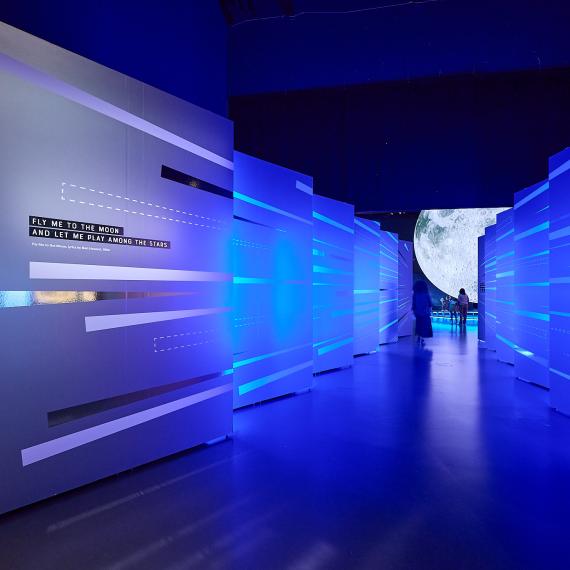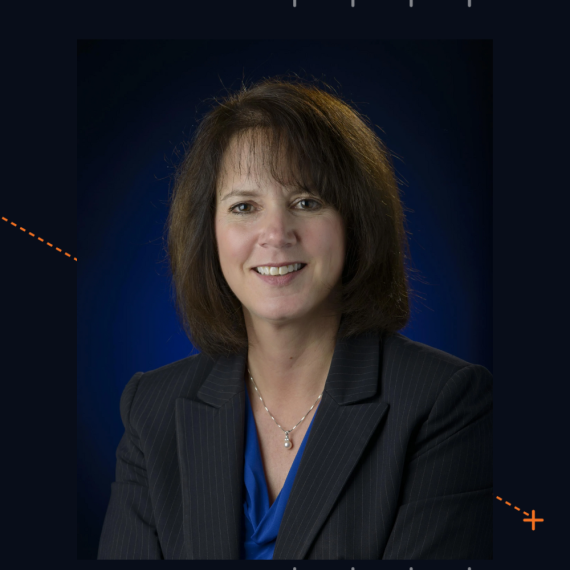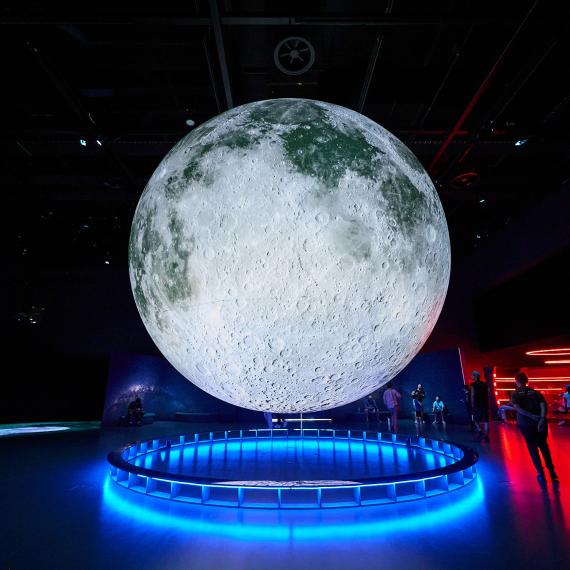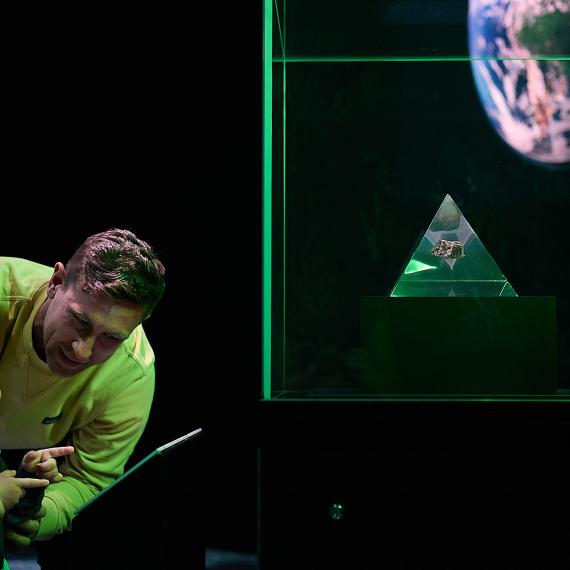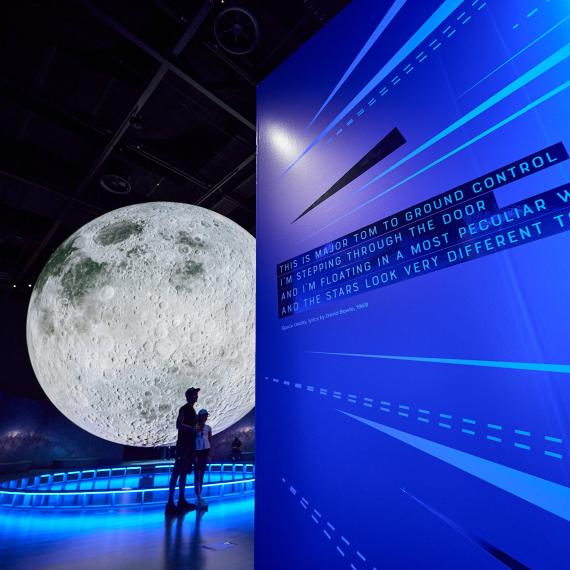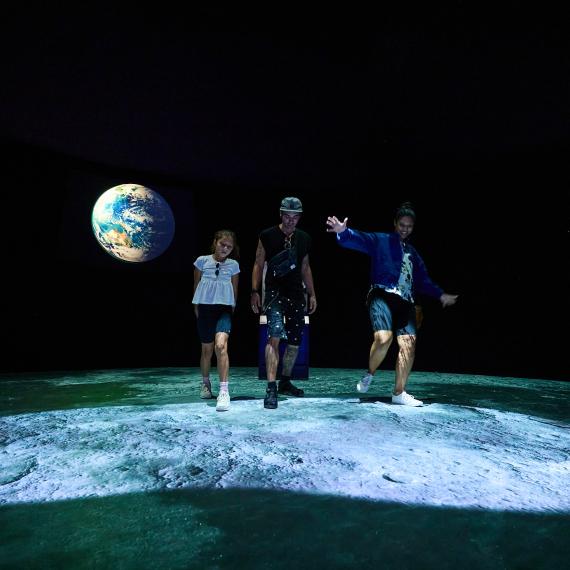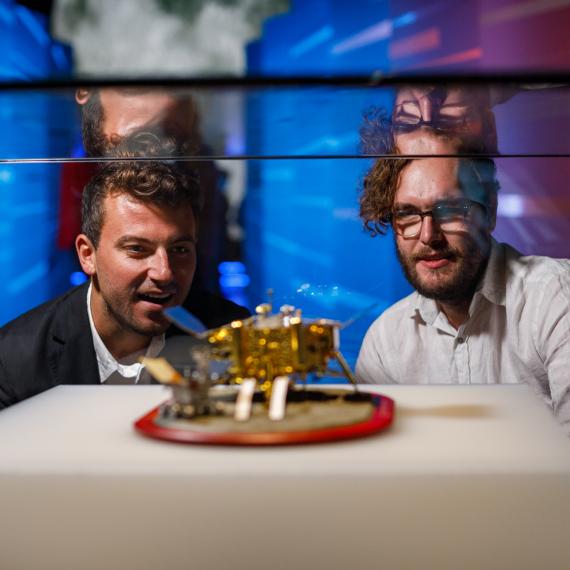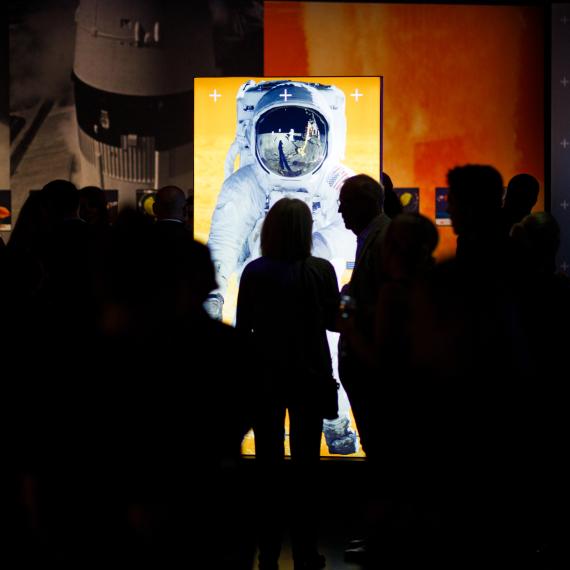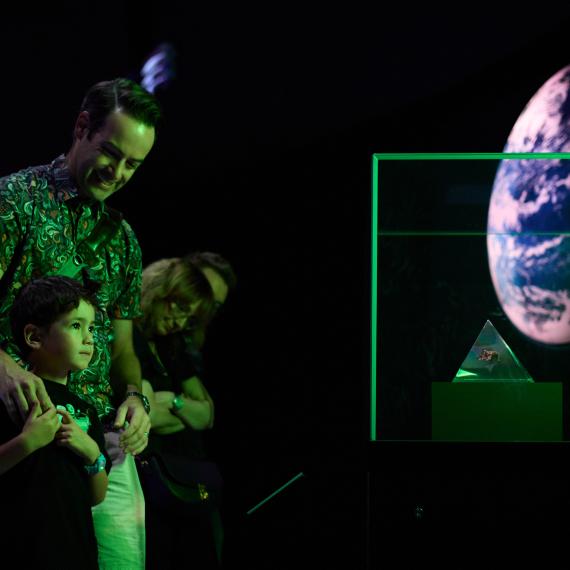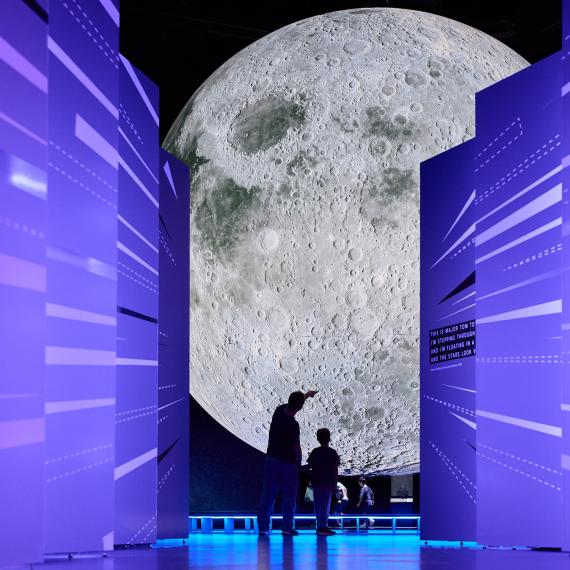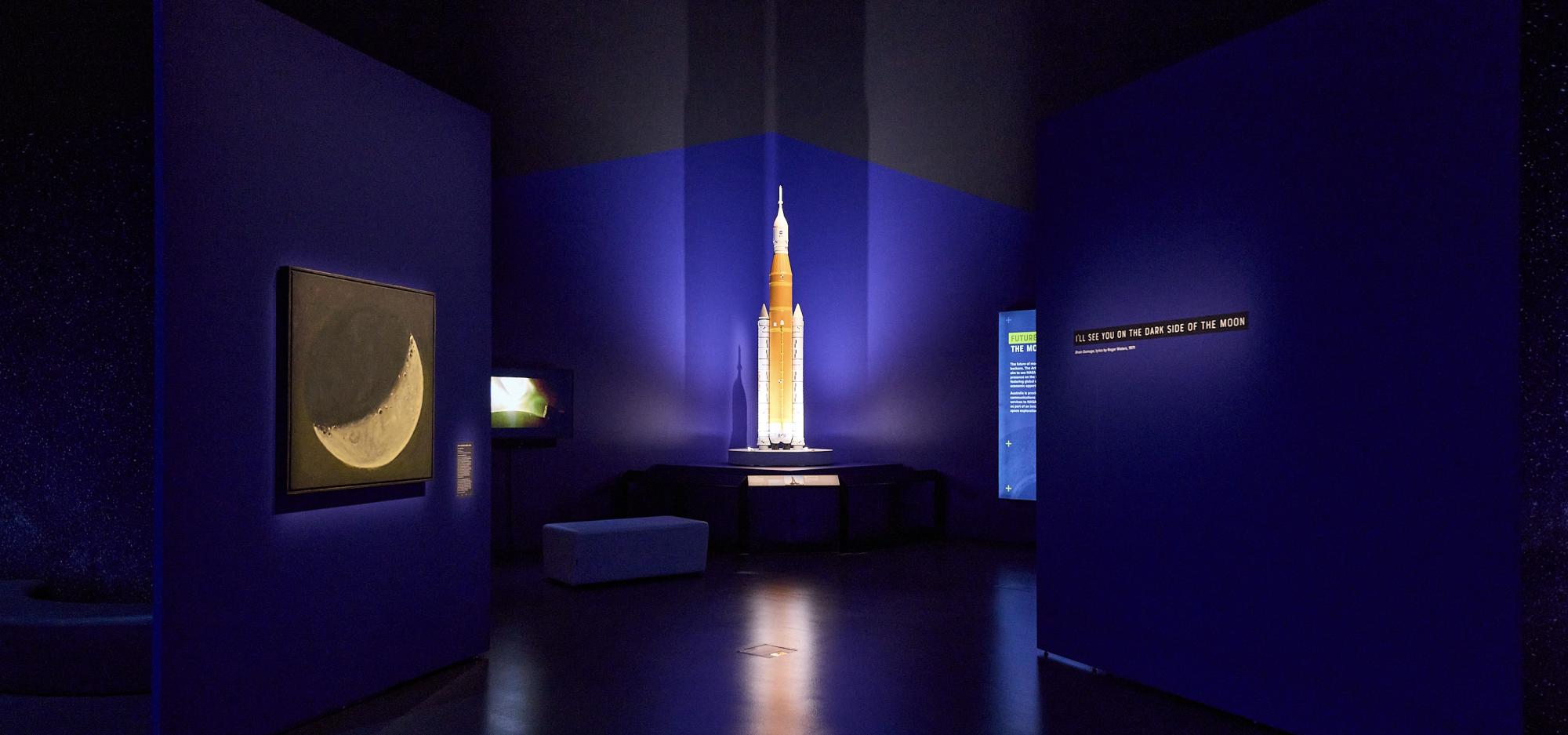
Discovering NASA's Artemis program with Professor Phil Bland
NASAs Artemis Program has set out a roadmap for a new era of human and scientific exploration of the Moon, with the goal of catalyzing an off-Earth space economy and building a foundation for human exploration of the rest of the solar system.
In this talk, from the WA Museum's Lunar Lounge series, Professor Phil Bland provided an overview of Artemis, and what the next decade of space exploration might look like.
-
Episode transcript
[Pre Recorded Introduction] Welcome to the Western Australian Museum Boola Bardip talks archive. The WA Museum Boola Bardip hosts a series of thought provoking talks and conversations tackling big issues, questions and ideas and is delighted to be able to share these with you through the talks archive. The talks archive is recorded on Whadjuk Nyoongar boodja. The Western Australian Museum acknowledges and respects the traditional owners of their ancestral lands, waters and skies.
Facilitator: Good evening everybody and welcome to the WA Museum Boola Bardip and the To the Moon exhibition. Before we get started this evening, I’d just like to acknowledge the land on which we're gathered today, the lands of the Whadjuk people of the Noongar nation, and may we pay our respects to elders, past and present. We have a very special guest speaker, Professor Phil Bland, who will be speaking about the Artemis program. Please make him feel welcome.
Phil Bland: My name is Phil Bland. I'm a planetary scientist and Director of the Space Science and Technology Centre at Curtin University. I'm a space geek! I just want to first thank the Museum for this absolutely incredible exhibition. It's amazing to be here. So, a big round of applause for WA Museum first [applause].
I also want to acknowledge the traditional owners of the land, the Noongar people. That's actually got specific relevance for me tonight. We have a space program at Curtin called the Binar Space Program. Binar is the Noongar word for fireball. Noongar people allowed us to use that word to name our program, thank you to them.
I'm doing two talks as part of this exhibition and moment about the moon. This one is all about the Artemis program and its background. Then in May I'll tell you about the mission that we're going to do from Curtin, and with partners, as a lunar orbiter and how we fit into that program.
Artemis is named that because Artemis was the twin sister of Apollo. Basically, this is us going back to the moon. The US is leading it. I've been a researcher in planetary science for 30 years and for the majority of that time I've been working with NASA and working with a whole bunch of people who really wanted to get back to the kind of the glory days of Apollo. Exploring and and seeing things for the first time that no one had ever seen. This is the first time I've seen those colleagues really excited about what the future might hold. So it's really a fascinating time for all of us .
What is Artemis? It's kind of hard to transmit how big an impact this is going to have on all our lives. It's going to be the thing that's kind of regularly in the news for at least the next decade and a half, if not more. It's going to be a complete global effort from Earth, with so many reach researchers and engineers putting stuff into low-Earth orbit and putting stuff at the moon. There are going to be 70 spacecraft going to the moon over the next decade.
It’s going to be a thing that is constantly there. Some of those are going to be robot spacecraft, some will be human. Taking humans to the moon. So, it's a crazy time to be here. To be doing space, or be excited about Space, or interested in space.
There's a lot of components that are kind of technical about Artemis, and then there’s the bigger picture stuff, which I love. Why the moon? Why the moon, again? I think space inspires like nothing else. Space and science inspires like nothing else. I'm a scientist, so I kind of hope that's true. This kind of program is basically set up so that its going to advance both science and technology. A big part of it is actually trying to establish an off-Earth space industry, an off-Earth economy.
We’ve got a space industry that NASA started by building rockets, weather satellites and communication satellite. That's grown into a half-trillion dollar industry. That happened without anyone really planning it. No one at NASA thought, “okay, if we build this and this and this, we'll have a half trillion dollar industry”. Now that's kind of what they're thinking. Can we do that and actually have an economy that isn't dependent on Earth? An economy going out into the universe, into the solar system. Artemis is about kind of laying the foundations for further exploration to Mars and beyond. It's really about human future in the solar system.
So what makes it different? As I say, it's a strategy, basically, for a sustained human presence in space. There's going to be dozens and dozens of spacecraft that are part of this strategy. A big part of this, is the idea of using the resources that we find out in space, and kind of living off the land. Rather than hauling everything up from Earth and trying to take it all with us, we're going to try and use stuff that we find there on the moon to support lunar activities. There's a lot of private sector involvement. That's a really big deal because people have looked at some of these programs before. One U.S. administration really likes it, and then the next one doesn't, and they'll bin it. But they can't really do that with this because they've signed too many contracts with the private sector. It’s kind of locked in now!
Importantly, it's not a race. Apollo was understood to be a race to the moon. It was understood by the American people to be a race to the moon. So when they made it, when they actually got there. All right. We won. Why are we continuing to run when we've won the race? Artemis is about all the other things that we get from space and space exploration, that make it kind of vital.
I'm going to actually try and answer the question that you get so often with Space, which is ‘why do we do it when there are so many problems here on Earth? I have reasons. My reasons aren’t the ones that get it funded. My reasons are science and because I think humans are an exploring species. I think it's in our DNA that we want to find out what's over the next horizon. Those are my reasons. But those aren't the reasons that something this expensive gets funded. Space is worth funding because it actually brings together the best and brightest in a country; the scientists and engineers, and you give them a ridiculously hard target. Guess what? They come up with some amazing stuff in trying to nail it. It turns out it's actually a really, really good way of generating a crazy amount of innovation.
Since Apollo, what we've realized is that you get about a times ten return on investment for every dollar spent. If you're a government and you want to know how to increase the size of your economy, you can put a dollar into space and you’ll get $10 back. You actually get about $3 back per year. For anyone who has investments, anyone whose buying a house.... there's not many things that are actually a better investment for a country than spending on space. Whatever you think people like me are doing, just give us the money and we're going to make a mint for you! [audience laughs] I can give you more detail in the questions if you want.
Some of the details about Artemis. One is the Commercial Lunar Payload Service Program. This is really NASA's first way of embedding the private sector in Artemis delivery. They allocated nine contracts to a whole bunch of different private sector companies. Some are the big established ones, some are startups. The idea is that those companies build their own landers and their own rovers, and then they'll be able to take payloads from either NASA or from other companies or universities and deliver those directly to the lunar surface.
It's actually got to the point now where you can go on a website and see the price that a company will charge you to get a kilo of stuff on the surface of the moon. It's becoming an accessible thing. Obviously, you need quite a bit of money to be able to do that, but the fact that it's there and in the world is fantastic. The first successful landing of one of these Commercial Lunar Payload Service landers happened just a month or two ago. Intuitive Machines was the first company to land successfully on the moon. It's a success! It did tip over, but still, you know, getting it there intact, able to take a picture is pretty incredible. Full marks to Intuitive Machines.
A key element of Artemis is the Space Launch System, there’s a beautiful model of it [gestures to an exhibit], and I wish I could have been there for the first one. It's the biggest launch vehicle that there's ever been. Elon Musk is doing an amazing job with Starship. SLS is spec to carry people, so it's got to go through a ridiculous amount of additional tests for it to meet that requirement.
I've got to take this moment to thank my friend and colleague, Barbara Cohen, who is standing here looking very proud. She's actually a lead scientist for Artemis and she gave me a whole bunch of these slides, so thanks, Barbara. This is SLS just before launch, with the moon beautifully placed there behind it, and here during launch. I've been lucky enough to see a launch from Cape Canaveral, a much smaller rocket than this, but it's exactly as amazing as you might imagine it to be from watching the movies. I didn't really have a sense of how bonkers that could be until I was there on this causeway, looking across the water to the rocket just as it took off. You can feel it in your chest when it launches. You can feel the shockwave in your chest and you kind of have this voice in your head shouting “go, go, go!”. I would love to have see this one.
Another key element in Artemus is the Orion capsule, which looks a lot like the Apollo capsule, but it's a lot more advanced and has a lot more room in it. It actually has beds so that the astronauts get to lie down if they want every now and then.
Now, the Human Landing Systems. The way that NASA has done this is again, to kind of open it up to private sector involvement. These things are going to look really, really different to what people have been used to seeing in the Apollo missions. Apollo was that kind of spidery little lander, the LEM, with really thin aluminium foil walls. They had to strip out every ounce of mass to make it work. There's actually a really good episode of From the Earth to the Moon, which is a drama documentary about Apollo. It’s just about the design of the LEM, which goes into all the detail about how they stripped everything out and managed to build it. These are going to be really different.
One is going to be a space X lander. Just look at the scale of that thing. You've got the astronauts at the bottom of it. This actually looks like Destination Moon, a classic sci fi movie. These things are going to be huge when they land this. We'll be able to take so much more stuff than we did in the past. So Space-x is building one, and Blue Origin is building another. Which is also going to be a pretty big vehicle.
Another key element of Artemis is Gateway. Gateway is going to be a kind of a lunar space station that's going to be orbiting the moon on a polar orbit. It kind of goes around like that. It’s going to act as a relay for communications with the surface, and a kind of halfway station for astronauts as they come and go. Apart from all the other stuff that this is going to do, it's a great training ground for how humans can operate in deep space, but still be close enough to get out of trouble if problems arise. Gateway is going to be part of that process. It's going to be built in stages. The core parts of it will be power and habitation, but it will grow to be a pretty decent sized space station serving all human and robotic applications on the surface of the moon going forward.
There are really cool, lunar exploration vehicles. Drawing on the kinds of stuff people saw in Apolo, but those are going to be kind of pressurized. You'll be able to basically be in there with t shirt and shorts, and then some are going to be unpressurized, like the Apollo rovers in space.
We will get in the end, probably in the early 2030’s. So maybe a decade from now, roughly, there'll be a lunar base and that will be permanently occupied. It's crazy to kind of say all this! This is actually costed, scheduled and contracts have been written. So it's really difficult to see how this isn't going to happen, but maybe I'm jinxing it. As a scientist, it's really important for me. It's lovely to see how fundamental that science is to the Artemis program. Science and scientific discoveries are foundational for Artemis.
Science has also enabled it in many ways. One of the interesting things is this idea of living off the land, that I mentioned. At the time of Apollo, folks didn't really think about that, you know. Everything was taken up from the surface of the Earth. We didn't really use anything on the moon. There's this idea called In-Situ Resource Utilization, which is a posh way of saying ‘living off the land’.
This makes use of a discovery of ice at the south pole of the moon. Planetary scientists actually made a prediction of this in 1961, and no one noticed. Another one was in 1979, and people did notice that one. As a scientist, you know, this is sometimes how it goes. You write a beautiful paper, you're really proud of it, no one ever cites it. However, folks did cite this one and they did notice it, and momentum built. In the end it's changed everything. The prediction was followed by the Clementine mission in the mid 90s. Clementine did the first map of the south pole of the moon, and it suggested that the prediction about ice was right. There were craters at the South Pole, that were permanently in shadow. Its just awesome to have this fantastic diagram [gestures to]. The moon spins, it doesn't have a tilt like the Earth. It does very slightly, but it's like two degrees. So sunlight comes in and you can imagine that the pole has got a really low angle. The rim of a crater shields the interior of the crater from any sunlight. There are places on the moon that have basically been in full shadow, no light for billions of years. Which is kind of freaky to think about. Those places have gradually accumulated ice over time as comets have impacted nearby.
Every now and then ice recondenses on the floor of those craters in the darkness and it's built up over time. That's a really big deal for the future of exploration on the moon, because ice is hydrogen and oxygen, and that's rocket fuel! You can harvest that ice and make rocket fuel. It's an awful lot easier to explore from the moon, which has very little gravity, than it is from the Earth which has a lot of gravity and an atmosphere. If we want to explore the solar system and get to Mars, doing that from the surface of the moon is so much easier than doing that from the Earth. If we can refuel rockets at the moon, then that'll be a revolutionary step in human exploration. Obviously for life support, for water, and all the rest of it. However, the key there is rocket fuel.
[Gestures] I love this image because this is actually the rim of Shackleton Crater, which is almost exactly at the south pole of the moon. That darkness looks so forbidding, and it is forbidding because down into that crater, is the lowest measured temperature in the solar system. There's places that are certainly colder in the solar system, but we've not measured temperatures there. It's 30 Kelvin down in that crater, which is -240 centigrade. The idea of harvesting ice sounds great, but harvesting ice in permanent darkness at –240 degrees, it'll be a challenge.
The other good thing about the South Pole is that you've got some places that are almost in permanent sunlight for the same reason. The rims of these craters shield the interior from the sun, but at that rim, it's getting almost permanent sunlight. So it's a great place for a base. The moon is on a two week cycle for a lunar day, and two weeks of darkness, which is pretty tough for things like batteries. But to have (permanent sunlight) at the rim of one of those craters is great.
Now, this is an image I really like [gestures] and it's kind of a strange one to get your head around. So you're at the South Pole, that crater in the middle is Shackleton and this is an integrated shadow over an entire lunar year. The places that are dark are the places that never get light and the places that are brightest are places that are almost always get light. It's kind of freaky. You've got places there that never do (get sunlight) and then places at the top, that are almost always in sunlight. Maybe the rim of Shackleton Crater would be prime real estate for the next century of lunar exploration.
This is another map showing the temperature in some of those craters. It's saying what I said before about the craters getting really, really cold. That prediction that now has been largely confirmed has defined where the first missions are going to go to. The first human landing on the moon since Apollo, is going to go really close to one of those poles. So we can confirm it straight away that there is ice there.
On the science side, only one scientist has ever visited the moon, Harrison Jack Schmitt. He's a geologist and he’s still alive. You can see here [gestures] he's really dusty because he’s a really enthusiastic geologist. He’s spent the last three days smashing up moon rocks and putting them in a bag to bring home, which is awesome. This [gestures] is an artist's impression of what an Artemis astronaut would be doing. I'll take issue with NASA's artist here, because speaking as a geologist, that's a really suspiciously rounded rock, and there's nothing to round rocks on the moon.
Artemis is all about science, science is fundamental. There's a whole bunch of science objectives throughout the program and society is helping. It's helping to think of ways to keep people safe on the moon and coming up with different options for how to harvest some of those resources. I say harvest rather than mine because, I was lucky enough to go on a trip to Antarctica one time and when you're in Antarctica, you go outside and you chop some ice off the glacier, you melt that and you have a cup of tea. When we get to the moon, we’ll basically be doing the same thing, just converting it into hydrogen oxygen. We don't really talk about mining ice in Antarctica for tea, so I think harvest is the right word. We don't ship liquid water to Antarctica. We use what's there. Hopefully you get the point but I will take questions.
There's a lot of different aspects to the science that we can do from the surface of the moon. A big one is that the moon has been orbiting us, its been in the same place in the solar system for 4.5 billion years. While the Earth has been recycling its surface for that whole period with plate tectonics, the moon has been recording everything that has happened at our position in the solar system for that entire period. There is so much that the moon can tell us about solar system history that we can't get from Earth. Apollo only scratched the surface of that, and so I think an awful lot of these objectives have actually come down to that fact. It’s going to be amazing to explore that.
Another big part of it is developing the technologies. One of the wonderful aspects of space exploration is that it brings together scientists and engineers to common endeavours. Speaking as someone who works with engineers every day, one of the lovely aspects of exploration is that it's the universe that sets the target. If you're a an engineer at JPL, the scientist says, “okay, I need a lander, a two ton rover on the surface of Mars”, and the engineer says, “okay, I have no idea how to do that”. They go away for six months and they say, “well okay, we could build a sky crane that can lower it down from a couple of hundred meters and then fly itself away.” That would work. They did that twice and it worked. And now, incidentally, you've got amazing code for remote operation of any robotic systems that fly, because they invented that at JPL for that application.
One of the things I'm super excited about is how humans and robots can kind of collaborate to further all of these different aspects of science and exploration. There’s a really awesome mission of Artemis called Endurance, which will have a rover that travels 2000km across, close to the South Pole of the moon. There's an impact basin there, which is the biggest impact basin in the solar system. It's going to travel all the way across and bring samples, like 100 samples, its going to recover. We’ll get an age for the biggest, oldest impact basin in the solar system from that mission. It's going to deliver those (samples) to the astronauts at the South Pole base, and then they'll fly them home.
This is the timeline [gestures], this is what the next decade is going to look like, really. The first mission, Artemis one, which was a robot mission, has flown and everything went great. It orbited the moon. The crew for Artemis 2 has been chosen. The launch date has been bumped, so that's going to be in about 18 months. The first human surface landing will be about a year later, and then the mission that's going to put Gateway in orbit will happen in 2028.
Throughout all of this, you're going to have probably 4 or 5 other missions of the robot missions happening each year to support these different elements of the program. It will become like monthly news - the next thing that is happening in Artemus. This is just the US part of that. There's an ESA (European Space Agency) version of that, the ISRO (Indian Space Research Organisation) and JAXA (Japanese Aerospace Exploration Agency). They've all got different elements that they're contributing. It's a global effort.
After Gateway, we’ll be seeing the base and then trying to work out what the next stage is, what do we need to do to get to Mars? Personally, I'd be really surprised if we don't see spacecraft in orbit ready to get to Mars by 2035. We are that close to bonkers things happening.
This is a picture of Gene Cernan, who was the last person on the moon. That was the Apollo 17 mission in 1972. I was three. I'm thinking about retirement now, so you know, it would be wonderful if all of this happened before I retire. It's been that long since we've done anything like this. The fastest aircraft that ever flew was before I was born. This is stuff that humans should do more of. We are explorers. We push the envelope, and we haven't in a long time.
This is Harrison (Jack) Schmitt again. So far as I can tell, this is the last picture that was taken by an astronaut, of another astronaut on the moon. This was taken by Gene Cernan of his colleague, just before they flew. Hopefully before too long, that artist's impression will become a reality and the first image of an Artemis astronaut maybe won't be quite as grainy as Neil Armstrong.
Thank you. [applause] I think there’s time for questions?
The question is “do we know how much water ice is on the moon?”. The estimates for the South Pole are in the range of 100 to about 400 million tonnes, so a lot! That's going to be probably thousands of years before we can use up more than a fraction of that. It is a finite resource, but to give you an idea, Saturn Five had about 2000 tons of fuel in it. So, it is a finite resource. Absolutely.
One of the things I'm really interested in is trying to provide NASA and those other agencies with alternatives for the South Pole rather than the South Pole ice. That's kind of driving our concept for a lunar orbiter, how we can maybe contribute to that and find some of those. I'll be talking about that in about a month.
Audience member: Considering we're already about halfway through 2024, and the moon landing is set to happen in September 2026. How realistic within that timeframe is it actually?
PB: The first estimate for a human on the moon was 2024. Timelines get bumped and I think the 2024 estimate was kind of imposed on NASA. I think the 2025, 2026 ones are a lot more realistic, but so many things can happen. You can have a problem with the rocket and that'll put you back six months, and the thing can sit on a launch pad for six months. You’ll see an administration that will talk big about a program and it'll get a bit of funding but it won't really have any momentum that this thing now has. You know, this has huge momentum. I think whether it's 2026 or 2027, it's going to happen.
Audience Member: thank you for your presentation. It was very informative and illuminating. In relation to the private contracting that's happening, what safeguards are there, obviously they’ve invested a lot, that there's not monopolization of the benefits that arise out of that?
PB: That's a really good question. That very issue has popped up because the initial contract for the human landing system was just for SpaceX, and Blue Origin kicked up a fuss, quite rightly. So you've now got two systems there, two designs for that system. They'll both have really high specs that they've got to meet because it’s a human lander. Any engineering that involves humans in space has a massively higher, technical requirement and safety requirements than if humans aren’t involved or aren't close to it.
So they'll have to meet really, really stringent requirements. Basically, you'll have two functional systems, and given the number of missions, it's entirely possible that you'll see them both in operation, on a pretty regular basis in the 2030’s.
Audience member: Are stars not visible from the moon?
PB: Stars are visible from the moon, yes. In a bunch of the photos, you can't see them, and because the old, you know, Hasselblad cameras, they were beautiful cameras, but they couldn't do that (juggling two exposures).
Audience Member: Can you explain how solar electric propulsion works? It was on one of the slides.
PB: No, I can't. I'm a scientist. Right? I just kind of bluff my way with the engineering stuff [laughs], but thank you. Thank you for your question [audience laughs]
Audience Member: I'm a little bit cynical about people playing nice together, I'm afraid. Given that the Chinese won’t join in the International Space Station , they’d would rather build their own, the Indians and the Chinese are both landing on the other side of the moon. Are we really going to play nice together on this, or where is it going? Is it another space race, basically?
PB: I think there's certainly an aspect of that. China has a really awesome and ambitious program. For a long time now, NASA hasn't actually allowed NASA scientists to collaborate in any way with Chinese scientists. So regardless of whether technology has evolved, NASA scientists haven't been allowed to collaborate. This is a really big deal and a really unusual step for a country to make. There is certainly an aspect of people not playing nice. I'm a person who wouldn’t really like to throw the baby out with the bathwater, and I'll accept a degree of human frailty and look at the glass more than halffull of of human ingenuity and exploration and all the lovely stuff.
Audience member: It seems that the moon needs its own time zone. What's that all about?
PB: My wife believes that time is a construct, I don't. There was a French philosophe who had a really nice idea that the human experience of time is closer to reality than the measured, quantified estimate of time. I'm not really answering your question there, but I think it's the moon has like 14 hour diurnal cycles. So you definitely need another day. The way that on missions folks do that is really try and sync in with Mission Control. When it was just Apollo and it was just daytime activities, they would say, “okay, we've been there three days” but that wasn't the time zone, sorry.
Facilitator: Fantastic. Well, that wraps up our presentation for this evening. Please give our presenter another round of applause.
PB: Thank you.
Facilitator: Thanks so much, folks. Exhibition is open until 9 p.m. Please enjoy.
Pre-recorded conclusion: Thanks for listening to the talks archive brought to you by the Western Australian Museum Boola Bardip. To listen to other episodes, please go to visit.museum.wa.gov.au/episodes/conversation where you can hear a range of talks and conversations. The talks archive is recorded on Whadjuk Nyoongar boodja. The Western Australian Museum acknowledges and respects the traditional owners of their ancestral lands, waters and skies.
More Episodes
Writer, puppeteer, and folklorist Clare Testoni tells the story of the Moon's many faces in folk and fairy tales around the world.
Join Dr Natasha Hurley-Walker, ARC Future Fellow at Curtin University, as they explain how lunar radio waves let us explore the universe.
Join the stellar Sandra E Connelly and Dr Phil Bland in the To the Moon exhibition for a fascinating conversation about NASA's seven-billion-dollar mission to explore Earth, the Sun and beyond!
Join Richard Tonello as they discuss and debunk all things lunar conspiracy, from the flapping flag to flat earth theories, missing stars and the moon's reflectivity index.
Explore the realm of off-earth habitation and hear how plants can be engineered for space exploration and altered Earth climates.
A conversation between Dr Chantal Bourgault Du Coudray & Lucy Peach, discussing the cultural significance of the moon and how this relates to women.
Join Professor Steven Tingay to discover how the moon itself is a telescope for radio astronomers.
Join Professor Eric Howell in this talk that delves into the heart of multi-messenger astronomy, highlighting its potential to decipher the intricate mechanisms driving these cosmic phenomena.
Join Dr Robin Cook on a celestial journey exploring the mesmerising interplay of the Sun, Moon, and Earth
In this talk Professor Bland outlines the mission that Curtin is developing to find ice on the Moon in accessible locations.
Join Xavier de Kestelier, Principal and Head of Design at Hassell, to hear about Hassell’s design journey and collaboration with the European Space Agency to develop a innovative concept for a thriving settlement on the lunar surface.
Join Dr Benjamin Kaebe, an engineer, researcher and teacher, as he discusses the opportunities of a Western Australian space economy.
In this lecture, Professor Katarina Miljkovic explores the impact origin of the Moon.
